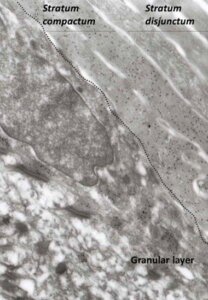Capture Water with Natural Moisturizing Factor by Rachida Nachat-Kappes
14 December 2021
Imagine suddenly being teleported from a humid tropical zone to a desert where drought reigns! Well, that’s what happens to our epidermis. While the deep “living” layers contain around 65% water, this rate drops to only 15 to 20% in the most superficial part of the horny layer, the stratum disjunctum, made up of the accumulation of dead anucleated cells, the corneocytes, resulting from the keratinocyte terminal differentiation programme. As the boundary with our environment, the stratum corneum (SC) was for a long time considered as a simple inert interface, lifeless and therefore of little use.
The continuous evolution in the understanding of the physiopathology of cutaneous disorders has highlighted the vital barrier functions that it provides. The barrier properties of the SC involve the formation of a rigid protein shell, the cornified envelope; inter-corneocyte lipids and their lamellar structural organization; but also, a mixture of small molecules called Natural Moisturizing Factor (NMF).
Composition of the NMF
The compaction of intermediate keratin filaments is ensured by the presence of a protein associated with intermediate filaments: filaggrin. But this protein also participates in skin hydration thanks to its proteolysis into hygroscopic amino acids, which are constituents of the NMF, in the most superficial part of the SC (Figure). More than 50% of the NMF is made up of free amino acids and water-soluble derivatives, such as pyrrolidone carboxylic acid (PCA) and urocanic acid (UCA), which are, respectively, a derivative of glutamine, which is highly hygroscopic, and a derivative of histidine, the deamination of which is catalyzed by a histidase. The NMF also contains lactic acid, sugars and other molecules with a very high-water uptake capacity.
Function of the NMF
NMF is present in the corneocytes and can represent up to 30% of the dry mass. Thanks to its strong humectant properties, it can capture a large quantity of water from the ambient humidity (up to 3 times the dry weight of the SC). The hydration provided by the NMF is essential for the activity of the numerous corneocyte enzymes, such as proteases involved in desquamation process (SCCE, SCTE, cathepsin D…), phospholipases, responsible for the acidification of the SC (~pH 5.2). This acidic pH regulates the skin microbiota, and activates lipid hydrolases necessary for ceramides synthesis and the integrity of the lipid barrier. Neutral and/or basic amino acids of NMF interact with keratins via ionic bonds and contribute to the elastic properties of the SC to maintain its relative flexibility. UCA acts as a natural UV filter, it has an immunomodulatory role and is involved in the acidification of the SC.
In humans, numerous abnormalities in filaggrin expression or maturation have been identified. Particularly in 2006, when two loss-of-function mutations of filaggrin were discovered which affect 9% of the European population and which are both a predisposing factor for atopic dermatitis and a cause of ichthyosis vulgaris, characterized by intense skin dryness.
Immunoelectron microscopy observation of filaggrin with immunogold staining method (Dark spots).
In the stratum disjunctum, the filaggrin is deiminated by PAD1 and 3 and is proteolyzed to produce
the free amino acids of the NMF (demonstrated by the disappearance of the gold particles).
Access free online MasterClass in French « Comprendre la peau et ses besoins » : https://formation.innovskin.com/registration
CONTACT
Rachida Nachat-Kappes
PhD, Cell and Skin Biologist, Scientific Consultancy, Education








 Follow us on Linkedin!
Follow us on Linkedin!
You must be logged in to post a comment.